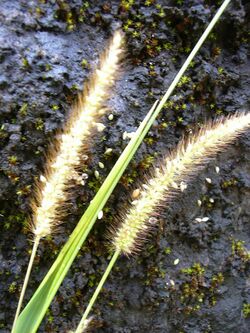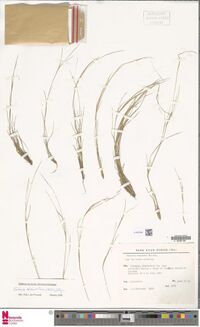Setaria
Topic: Biology
 From HandWiki - Reading time: 3 min
From HandWiki - Reading time: 3 min
| Foxtail | |
|---|---|

| |
| Setaria parviflora in Hawai'i | |
| Scientific classification | |
| Kingdom: | Plantae |
| Clade: | Tracheophytes |
| Clade: | Angiosperms |
| Clade: | Monocots |
| Clade: | Commelinids |
| Order: | Poales |
| Family: | Poaceae |
| Subfamily: | Panicoideae |
| Supertribe: | Panicodae |
| Tribe: | Paniceae |
| Subtribe: | Cenchrinae |
| Genus: | Setaria P.Beauv. 1812, conserved name not Ach. ex Michx. 1803 (a lichen)[1][2] |
| Type species | |
| Setaria viridis | |
| Synonyms[4] | |
| |
Setaria is a widespread genus of plants in the grass family.[5][6] The name is derived from the Latin word seta, meaning "bristle" or "hair", which refers to the bristly spikelets.[7]
The genus includes over 100 species distributed in many tropical and temperate regions around the world,[8] and members are commonly known as foxtail or bristle grasses.[2][9][10][11][12][13]
Description
The grass is topped by a cylindrical long-haired head, which tend to droop when ripe. The seeds are less than 6 millimetres (1⁄4 inch) in length.[14]
Species
- Formerly included[4]
Numerous species were once considered members of Setaria but have since been reassigned to the following genera: Brachiaria, Dissochondrus, Echinochloa, Holcolemma, Ixophorus, Oplismenus, Panicum, Paspalidium, Pennisetum, Pseudoraphis, Setariopsis, and Urochloa
Uses
The grains can be eaten raw, though are hard and can be bitter; boiling can reduce both of these properties.[14]
Several species have been domesticated and used as staple crops throughout history: foxtail millet (S. italica), korali (S. pumila) in India, and, before the full domestication of maize, Setaria macrostachya in Mexico.[18] Several species are still cultivated today as food or as animal fodder, such as foxtail millet and korali (S. pumila), while others are considered invasive weeds.[19] S. italica and S. viridis are being developed as genetic model systems for the study of monocots and bioenergy grasses.[20]
Other species that have been cultivated as crops include S. palmifolia (highland pitpit) of Papua New Guinea, where it is cultivated as a green vegetable; S. parviflora (knot-root foxtail), historically cultivated in Mesoamerica; and S. sphacelata (African bristle grass) of Sudan, a "lost millet" of Nubia.[21]
See also
- Hendrik de Wit, a botanist who studied Setaria
References
- ↑ Tropicos, Setaria Ach. ex Michx.
- ↑ 2.0 2.1 "Genus: Setaria P. Beauv.". Germplasm Resources Information Network. United States Department of Agriculture. 2007-10-05. http://www.ars-grin.gov/cgi-bin/npgs/html/genus.pl?11106.
- ↑ lectotype designated by Hitchcock, Contr. U.S. Natl. Herb. 22(3): 156 (1920)
- ↑ 4.0 4.1 4.2 Kew World Checklist of Selected Plant Families
- ↑ Palisot de Beauvois, Ambroise Marie François Joseph. 1812. Essai d'une Nouvelle Agrostographie page 51 in Latin
- ↑ Palisot de Beauvois, Ambroise Marie François Joseph. 1812. Essai d'une Nouvelle Agrostographie plate XIII (13), figure III (3) line drawing of Setaria viridis
- ↑ Quattrocchi, Umberto (2000). CRC World Dictionary of Plant Names: Common Names, Scientific Names, Eponyms, Synonyms, and Etymology. 4: R-Q. CRC Press. p. 2470. ISBN 0-8493-2673-7.
- ↑ Aliscioni, S., et al. An overview of the genus Setaria (Poaceae: Panicoideae: Paniceae) in the Old World: Systematic revision and phylogenetic approach. Abstract. Botany 2004. Salt Lake City. August 3, 2004.
- ↑ Flora of China Vol. 22 Page 1, 499, 531 狗尾草属 gou wei cao shu Setaria P. Beauvois, Ess. Agrostogr. 51. 1812
- ↑ Biota of North America Program 2013 county distribution maps
- ↑ Altervista Flora Italiana
- ↑ Atlas of Living Australia
- ↑ Sanbi Red List of South African Plants
- ↑ 14.0 14.1 (in en-US) The Complete Guide to Edible Wild Plants. United States Department of the Army. New York: Skyhorse Publishing. 2009. pp. 56. ISBN 978-1-60239-692-0. OCLC 277203364. https://www.worldcat.org/oclc/277203364.
- ↑ The Plant List search for Setaria
- ↑ "Setaria". Integrated Taxonomic Information System. https://www.itis.gov/servlet/SingleRpt/SingleRpt?search_topic=TSN&search_value=41229. Retrieved 2013-11-16.
- ↑ "GRIN Species Records of Setaria". Germplasm Resources Information Network. United States Department of Agriculture. http://www.ars-grin.gov/cgi-bin/npgs/html/splist.pl?11106.
- ↑ Diao, Xianmin; Jia, Guanqing (2017). "Origin and Domestication of Foxtail Millet". Genetics and Genomics of Setaria. Plant Genetics and Genomics: Crops and Models. 19. pp. 61–72. doi:10.1007/978-3-319-45105-3_4. ISBN 978-3-319-45103-9.
- ↑ Dekker, Jack (29 February 2004). "4". in Inderjit. Weed Biology and Management. Kluwer Academic Publishers. pp. 65–67. ISBN 9781402017612.
- ↑ Li, P.; Brutnell, T. P. (2011-03-31). "Setaria viridis and Setaria italica, model genetic systems for the Panicoid grasses". Journal of Experimental Botany 62 (9): 3031–3037. doi:10.1093/jxb/err096. ISSN 0022-0957. https://doi.org/10.1093/jxb/err096.
- ↑ Fuller, Dorian Q. (2014). "Millets: Origins and Development". Encyclopedia of Global Archaeology. New York, NY: Springer New York. pp. 4945–4948. doi:10.1007/978-1-4419-0465-2_2181. ISBN 978-1-4419-0426-3.
External links
- Setaria. California Department of Food and Agriculture.
Wikidata ☰ Q157389 entry
 |
 KSF
KSF
